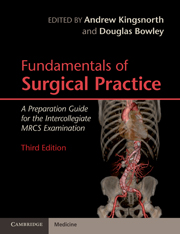Book contents
- Frontmatter
- Contents
- List of contributors
- Preface
- Section 1 Basic Sciences Relevant to Surgical Practice
- Section 2 Basic Surgical Skills
- Section 3 The Assessment and Management of the Surgical Patient
- Section 4 Perioperative Care of the Surgical Patient
- Section 5 Common Surgical Conditions
- 16 Assessment and early treatment of patients with trauma
- 17 Fundamentals of the central nervous system
- 18 Fundamentals of head and neck surgery
- 19 Fundamentals of thoracic surgery
- 20 Oesophago-gastric surgery
- 21 Fundamentals of hepatobiliary and pancreatic surgery
- 22 Fundamentals of endocrine surgery
- 23 Fundamentals of the breast
- 24 Lower gastrointestinal surgery
- 25 Fundamentals of the genitourinary system
- 26 Hernias
- 27 Fundamentals of vascular surgery
- 28 Fundamentals of orthopaedics
- 29 Fundamentals of plastic surgery
- 30 Surgical care of the paediatric patient
- 31 Fundamentals of organ transplantation
- Index
- References
20 - Oesophago-gastric surgery
Published online by Cambridge University Press: 03 May 2011
- Frontmatter
- Contents
- List of contributors
- Preface
- Section 1 Basic Sciences Relevant to Surgical Practice
- Section 2 Basic Surgical Skills
- Section 3 The Assessment and Management of the Surgical Patient
- Section 4 Perioperative Care of the Surgical Patient
- Section 5 Common Surgical Conditions
- 16 Assessment and early treatment of patients with trauma
- 17 Fundamentals of the central nervous system
- 18 Fundamentals of head and neck surgery
- 19 Fundamentals of thoracic surgery
- 20 Oesophago-gastric surgery
- 21 Fundamentals of hepatobiliary and pancreatic surgery
- 22 Fundamentals of endocrine surgery
- 23 Fundamentals of the breast
- 24 Lower gastrointestinal surgery
- 25 Fundamentals of the genitourinary system
- 26 Hernias
- 27 Fundamentals of vascular surgery
- 28 Fundamentals of orthopaedics
- 29 Fundamentals of plastic surgery
- 30 Surgical care of the paediatric patient
- 31 Fundamentals of organ transplantation
- Index
- References
Summary
Anatomy
Oesophagus
The oesophagus is 25 cm long, extending from the pharynx to the cardia. It lies in the posterior mediastinum, and is traditionally divided into upper, middle and lower thirds. The upper third is closely related anteriorly to the trachea, down to the carina. The middle third extends from the carina to approximately 7 cm above the diaphragmatic hiatus, and is related anteriorly to the pericardium. The lower third extends through the hiatus to include a short segment of intra-abdominal oesophagus, and is related (in the thorax) to the left atrium. The oesophagus receives its blood supply via direct branches from the aorta, and branches from other organs such as thyroid, trachea and stomach. Venous drainage is via the azygos and hemiazygos veins. The vagus nerves lie closely applied to the surface of the oesophagus, and it must be remembered that the right recurrent laryngeal branch arises in the upper thorax, passing around the subclavian artery, and the left recurrent laryngeal branch passes around the ductus arteriosus. These branches can be injured during surgery on the upper oesophagus. The oesophageal hiatus is surrounded by the crura, pillars of diaphragmatic muscle that help contribute to the lower oesophageal sphincter. A hiatus hernia involves herniation of the proximal stomach through this area, and can predispose to gastro-oesophageal reflux. Giant hiatus hernia can occur where most, or all, of the stomach herniates into the thoracic cavity.
- Type
- Chapter
- Information
- Fundamentals of Surgical PracticeA Preparation Guide for the Intercollegiate MRCS Examination, pp. 343 - 357Publisher: Cambridge University PressPrint publication year: 2011

